|

by Fraser Cain
17 January,
2017
from
UniverseToday Website
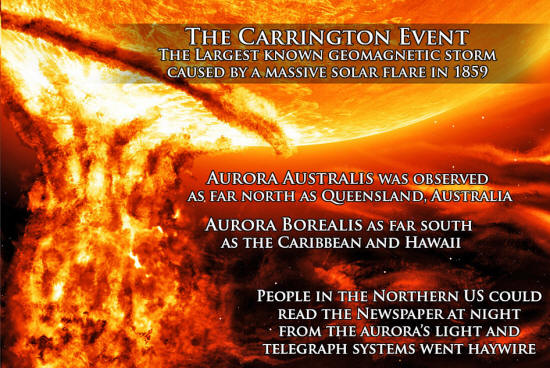
Isn't modern society
great?
With all this technology
surrounding us in all directions. It's like a cocoon of sweet,
fluffy silicon. There are chips in my fitness tracker, my bluetooth
headset, mobile phone, car keys and that's just on my body.
At all times in the Cain household, there dozens of internet devices
connected to my Wi-Fi router. I'm not sure how we got to the point,
but there's one thing I know for sure, more is better.
If I could use two
smartphones at the same time, I totally would.
And I'm sure you agree, that without all this technology, life would
be a pale shadow of its current glory. Without these devices, we'd
have to actually interact with each other. Maybe enjoy the beauty of
nature, or something boring like that.
It turns out, that terrible burning orb in the sky,
the Sun, is
fully willing and capable of bricking our precious technology. It's
done so in the past, and it's likely to take a swipe at us in the
future.
I'm talking about
solar storms, of course, tremendous blasts of
particles and radiation from the Sun which can interact with the
Earth's magnetosphere and overwhelm anything with a wire.
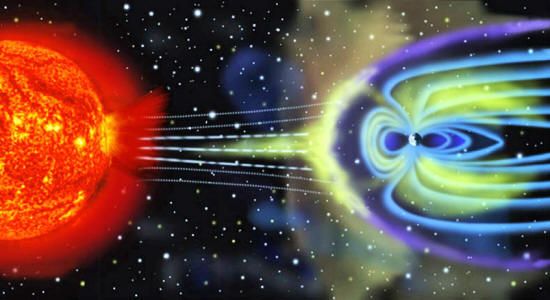
Credit: NASA
In fact, we got a sneak preview of this back in 1859, when a massive
solar storm engulfed the Earth and ruined our old timey technology.
It was known as
the Carrington Event.
Follow your imagination back to Thursday, September 1st, 1859. This
was squarely in the middle of the Victorian age.
And not the awesome, fictional Steampunk Victorian age where
spectacled gentleman and ladies of adventure plied the skies in
their steam-powered brass dirigibles.
No, it was the regular crappy Victorian age of cholera and child
labor. Technology was making huge leaps and bounds, however, and the
first telegraph lines and electrical grids were getting laid down.
Imagine a really primitive version of today's electrical grid and
internet.
On that fateful morning, the British astronomer Richard
Carrington turned his solar telescope to the Sun, and was amazed
at the huge sunspot complex staring back at him.
So impressed that he drew
this picture of it:
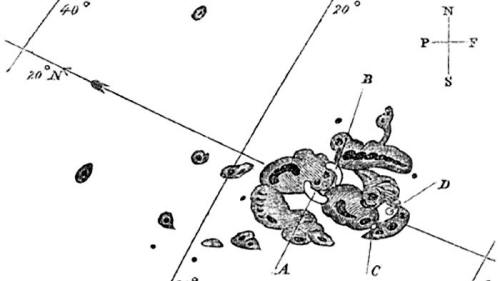
Richard Carrington's sketch
of the
sunspots seen just before
the
1859 Carrington event.
While he was observing the sunspot, Carrington noticed it flash
brightly, right in his telescope, becoming a large kidney-shaped
bright white flare.
Carrington realized he was seeing unprecedented activity on the
surface of the Sun. Within a minute, the activity died down and
faded away.
And then about 5 minutes later, Aurora activity erupted across the
entire planet. We're not talking about those rare Northern Lights
enjoyed by the Alaskans, Canadians and Northern Europeans in the
audience.
We're talking about everyone, everywhere on Earth. Even in
the tropics.
In fact, the brilliant auroras were so bright you could read a book
to them.
The beautiful night time auroras was just one effect from the
monster solar flare. The other impact was that telegraph lines and
electrical grids were overwhelmed by the electricity pushed through
their wires.
Operators got electrical
shocks from their telegraph machines, and the telegraph paper lit on
fire.
What happened? The most powerful solar flare ever observed is what
happened...
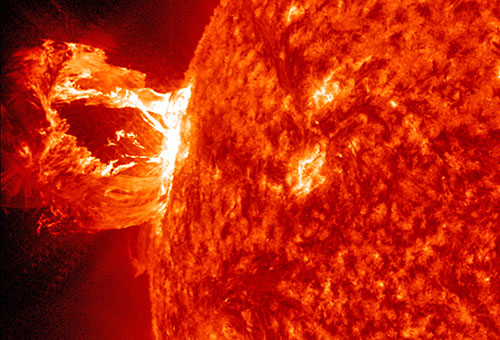
In this image,
the
Solar Dynamics Observatory (SDO)
captured an X1.2 class solar flare,
peaking
on May 15, 2013.
Credit:
NASA/SDO
A solar flare occurs because the Sun's magnetic field lines can get
tangled up in the solar atmosphere.
In a moment, the magnetic
fields reorganize themselves, and a huge wave of particles and
radiation is released.
Flares happen in three stages:
-
First, you get the precursor stage,
with a blast of soft X-ray radiation
-
This is followed by the
impulsive stage, where protons and electrons are accelerated off the
surface of the Sun
-
Finally, the
decay stage, with another burp of X-rays as the flare dies
down
These stages can happen in just a few seconds or drag out over an
hour.
Remember those particles hurled off into space? They take several
hours or a few days to reach Earth and interact with our planet's
protective
magnetosphere, and then we get to see beautiful auroras
in the sky.
This geomagnetic storm causes the Earth's magnetosphere to jiggle
around, which drives charges through wires back and forth, burning
out circuits, killing satellites, overloading electrical grids.
Back in 1859, this wasn't a huge deal, when our quaint technology
hadn't progressed beyond the occasional telegraph tower.
Today, our entire civilization depends on wires. There are wires in
the hundreds of satellites flying overhead that we depend on for
communications and navigation.
Our homes and businesses
are connected by an enormous electrical grid:
Airplanes, cars,
smartphones, this camera I'm using...
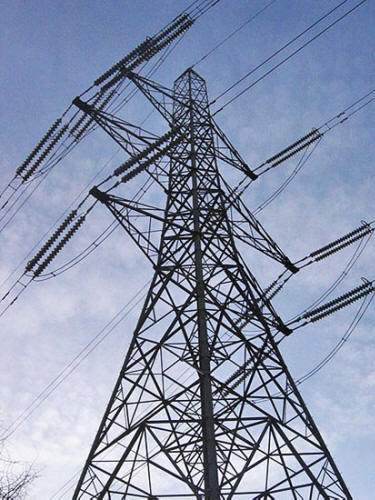
Credit: Wikimedia Commons.
Everything is electronic, or controlled by electronics.
Think it can't happen? We got a sneak preview back in March 1989,
when a much smaller geomagnetic storm crashed into the Earth. People
as far south as Florida and Cuba could see auroras in the sky, while
North America's entire interconnected electrical grid groaned under
the strain.
The Canadian province of Quebec's electrical grid wasn't able to
handle the load and went entirely offline. For 12 hours, in the
freezing Quebec winter, almost the entire province was without
power. I'm telling you, that place gets cold, so this was really bad
timing.
Satellites went offline, including NASA's TDRS-1 communication
satellite, which suffered 250 separate glitches during the storm.
And on July 23, 2012, a Carrington-class solar superstorm blasted
off the Sun, and off into space. Fortunately, it missed the Earth,
and we were spared the mayhem.
If a solar storm of that magnitude did strike the Earth, the cleanup
might cost $2 trillion, according to a study by the National Academy
of Sciences.
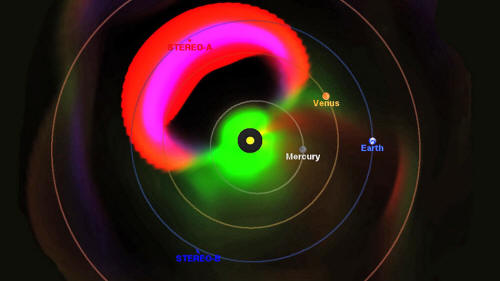
The July 23, 2012 CME would have caused
a
Carrington-like event had it hit Earth.
Thankfully for us and our technology, it missed.
Credit:
NASA's Goddard Space Flight Center
It's been 160 years since the Carrington Event, and according to ice
core samples, this was the most powerful solar flare over the last
500 years or so.
Solar astronomers
estimate solar storms like this happen twice a millennium, which
means we're not likely to experience another one in our lifetimes.
But if we do, it'll cause worldwide destruction of technology and
anyone reliant on it. You might want to have a contingency plan with
some topic starters when you can't access the internet for a few
days.
Locate nearby interesting
nature spots to explore and enjoy while you wait for our
technological civilization to be rebuilt.
Video
Seven Times...
Solar Storms have
Affected Earth
by Matt
Liddy
01 April
2015
from
ABC.Au Website
Solar storms,
which scientists warn
could disrupt communications
systems,
are recorded as causing chaos
on Earth
as early as the mid-1800s,
when they sparked fires
and brought down telegraph
systems.
What are solar storms?
Solar storms are
weather events on
the Sun that produce a huge release of energy,
shooting heat, light and particles of plasma out into space.
In a large
eruption, the Sun ejects,
-
a flash of
heat and light (solar flares)
-
a huge ball
of plasma (coronal mass ejections)
-
sub-atomic
particles that can travel at up to 80 per cent of the speed
of light (solar energetic particles)
These events can
have widespread - and potentially devastating - effects on Earth.
1859 - Telegraph
machines keep working when unplugged

Drawing of
sunspots
by English
astronomer Richard Carrington
from 1859
(Supplied)
A solar storm known
as the 'Carrington event' disrupted telegraph systems around the
world in 1859.
In Boston,
telegraph operators reported they were still able to
send messages even when they disconnected the machines'
batteries, relying instead on the,
"celestial
power induced in the telegraph lines by the magnetic
disturbances".
The geomagnetic
storms sparked fires at other telegraph offices.
A bright glow was
visible in the night sky in many parts of the world:
Brisbane's
Moreton Bay Courier reported that a southern aurora had,
"lit
up the heavens with a gorgeous hue of red".
1882 - Telegraph,
telephone systems disrupted
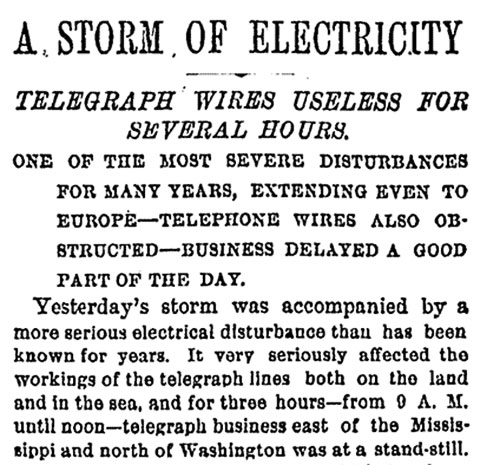
The NYT reports
on the impact
of a solar storm
in November 1882.
(NY Times)
A solar storm is
blamed for widespread communications problems on November 17, 1882.
The New York
Times reported
telegraph wires were useless for several hours, resulting in,
"very much
annoyance by reason of the delay in the transmission of
business".
Telephones were
affected too, with people reporting,
"a buzzing,
ringing noise rather than any well-defined sound while
attempting communication".
The South
Australian Advertiser reported a "magnificent
aurora australis" visible in Melbourne, which "at its best
resembled a blood-red arch".
1989 - Astronauts report
burning in their eyes
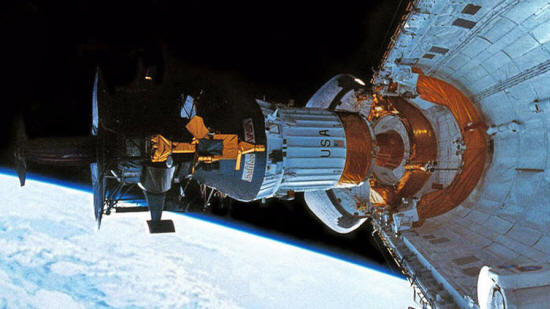
Space shuttle
Atlantis
releases the Galileo spacecraft
during its October 1989
mission.
(NASA)
Astronauts aboard
the space shuttle Atlantis were aloft during a solar storm in
October 1989, and,
"reported
burning in their eyes, a reaction of their retinas to the
solar particles", according to the book Storms from The Sun.
"The crew was
ordered to go to the 'storm shelter' in the farthest interior of
the shuttle, the most shielded position. But even when hunkered
down inside the spacecraft, some astronauts reported seeing
flashes of light even with their eyes closed," the book notes,
...adding
that if the astronauts had been on a deep-space mission or working
on the Moon, there was a 10 per cent chance they would have died.
1989 - Solar storms shut
down power grids

Artist's
depiction of solar wind
colliding with
Earth's magnetosphere.
(NASA)
In March 1989,
space weather events caused transformers to fail,
prompting a nine-hour blackout affecting more than 6 million
people in Quebec, Canada.
Communications
networks around the globe
were affected, prompting speculation the Kremlin was jamming
radio signals, while
short-wave radio frequencies used by commercial pilots also
suffered fadeouts.
"In space, some
satellites actually tumbled out of control for several hours,"
NASA says.
Space weather
researcher and electrical engineer David Boteler says the
1989 event,
"is the most
significant space weather event for the power industry", and
changed many minds about the potential impacts.
"Before 1989,
believing in space weather effects on power systems was regarded
by some as equivalent to believing in little green men from
outer space,"
he said.
1989 - Canadian share
trades halted
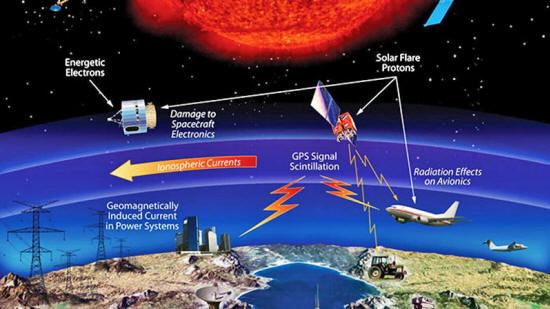
An excerpt from a
NASA infographic
shows how space
weather can
affect
technological infrastructure.
(NASA)
The Toronto stock
market in Canada halted trading after solar activity crashed a
series of computer hard drives in August 1989.
Trading was stopped
for three hours.
"I don't know
what the gods were doing to us,"
said exchange vice-president John Kane.
2012 - Earth has close
shave with 'extreme' solar storm
NASA says the Earth
had a "perilous" close shave with an "extreme" solar storm in 2012.
The storm, believed
to be the most powerful solar event in up to 150 years, missed the
Earth by about a week.
"If it had hit,
we would still be picking up the pieces," Daniel Baker of
the University of Colorado said in a NASA statement two years
after the event.
NASA scientists
said that if Earth had been hit, the event could have knocked our
technology back at least 150 years.
2014 - Scientists issue
solar storm warning
Scientists warn two
big explosions on the surface of the Sun will cause a moderate to
strong geomagnetic storm on Earth,
possibly disrupting radio and satellite communications.
The unusual storm
is not likely to wreak havoc with personal electronics but may cause
colorful auroras or displays of the Northern Lights across the
northern United States.
"We don't
expect any unmanageable impacts to national infrastructure from
these solar events at this time but we are watching these events
closely," said Thomas Berger, director of the Space Weather
Prediction Centre at the National Oceanic and Atmospheric
Administration.
Are solar storms really
that big a threat?
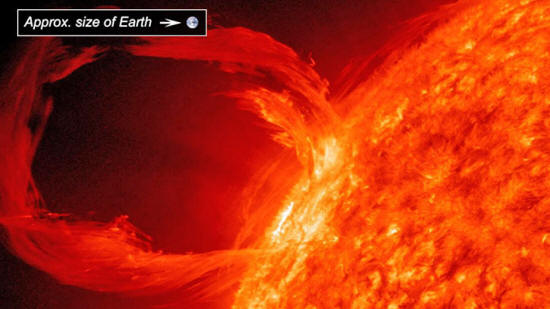
A solar eruptive
prominence
as seen in
extreme UV light on March 30, 2010
with Earth
superimposed into the image
to provide a
sense of scale.
(NASA/SDO)
A storm similar to
the one that missed Earth by a week in 2012 could have an
economic impact of more than $2 trillion, according to a study
by the US National Academy of Sciences.
NASA says that is
20 times greater than the costs of Hurricane Katrina, which
devastated New Orleans in 2005.
In a February 2012
paper (On
the Probability of Occurrence of Extreme Space Weather Events) published in Space Weather, physicist Pete Riley of
Predictive Science analyzed records of solar storms going back
more than 50 years and calculated the odds that a storm as big as
1859's huge 'Carrington event' would hit the Earth in the next 10
years.
He
arrived at a likelihood of 12 per cent...
|











